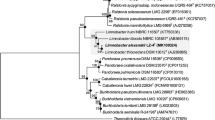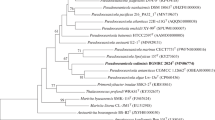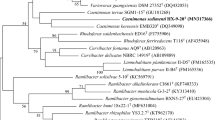Abstract
Two Gram-stain negative, facultative anaerobic, oxidase-negative, catalase-positive bacilli, designated as strains TMQ4T and TMQ2, were isolated from Xiaoshi Island, China, using prey-traps. Growth was observed within the ranges 25–45 °C (optimally at 37 °C), pH 6.5–9.0 (optimally at pH 7.5–8.0) and 1–8% NaCl (optimally at 3–4%, w/v). The draft genome sequences of strains TMQ4T and TMQ2 contained 184 contigs of 5,609,735 bp with a G+C content of 64.4% and 148 contigs of 5,589,985 bp with a G+C content of 65.0%, respectively. Phylogenetic analysis based on 16S rRNA gene sequences showed that both strains belonged to the genus Lujinxingia with the similarity of 98.9%. The phylogenetic and phylogenomic topologies and analyses demonstrated that both strains clustered together and differentiated from the closest neighbour, Lujinxingia sediminis SEH01T. Genomic analyses showed that two strains lost the biosynthesis pathway of several chemical compounds. Iso-C15:0 was contained in the predominant cellular fatty acids in both strains. The major polar lipids of both strains consisted of diphosphatidylglycerol, phosphatidylglycerol, phosphatidylethanolamine, and unidentified lipids; and the respiratory quinone was menaquinone MK-7 for both strains. Both strains predated other bacteria, including Owenweeksia hongkongensis JCM 12287T and Paraliobacillus ryukyuensis DSM 15140T, and were lured with one prey Acinetobacter baumannii ATCC 19606T in prey-trap. Combining genomic analyses, two strains had the predatory indices of 2, similar to representative typical bacterial predators. The physiological, biochemical, and phylogenetic properties suggest that the two strains represent a novel species within the genus Lujinxingia. The name Lujinxingia vulgaris sp. nov. is proposed, with strain TMQ4T (= KCTC 62851T = MCCC 1H00392T) as type strain and strain TMQ2 (= KCTC 72,079 = MCCC 1H00381) as reference strain.




Similar content being viewed by others
Abbreviations
- GTDB:
-
Genome Taxonomy Database
- HPLC:
-
High Performance Liquid Chromatography
- MA:
-
Marine agar 2216
- MB:
-
Marine broth 2216
- MCCC:
-
Marine Culture Collection of China
- MEGA:
-
Molecular Evolutionary Genetics Analysis
- MIDI:
-
Microbial Identification System
- NCBI:
-
National Centre of Biotechnology Information
- RAST:
-
Rapid Annotation using Subsystem Technology
- TLC:
-
Thin layer chromatography
- UBCG:
-
Up-to-date Bacterial Core Gene Set
References
Arend KI, Schmidt JJ, Bentler T et al (2020) Myxococcus xanthus predation of Gram-positive or Gram-negative bacteria is mediated by different bacteriolytic mechanisms. Appl Environ Microbiol 87:e02382-e2320
Bachran M, Kluge S, Lopez-Fernandez M, Cherkouk A (2019) Microbial diversity in an arid, naturally saline environment. Microb Ecol 78:494–505
Bernardet JF, Nakagawa Y, Holmes B (2002) Proposed minimal standards for describing new taxa of the family Flavobacteriaceae and emended description of the family. Int J Syst Evol Microbiol 52:1049–1070
Buyer JS (2002) Rapid sample processing and fast gas chromatography for identification of bacteria by fatty acid analysis. J Microbiol Methods 51:209–215
Castejón OJ (2003) Sample preparation methods for scanning electron microscopy. In: Scanning electron microscopy of cerebellar cortex. Springer, Boston, pp 1–24
Chaumeil PA, Mussig AJ, Hugenholtz P, Parks DH (2019) GTDB-Tk: a toolkit to classify genomes with the Genome Taxonomy Database. Bioinformatics 36:1925–1927
Cheng C, Wei H, Xu C, Xie X, Jiang S et al (2018) Maternal soluble fiber diet during pregnancy changes the intestinal microbiota, improves growth performance, and reduces intestinal permeability in piglets. Appl Environ Microbiol 84:e01047-e1118
Guo LY, Li CM, Wang S, Mu DS, Du ZJ (2019) Lujinxingia litoralis gen. nov., sp. Nov. and Lujinxingia sediminis sp. Nov., two new representatives in the order Bradymonadales. Int J Syst Evol Microbiol 69:2767–2774
Hahn M, Schmidt J, Koll U, Rohde M, Verbarg S et al (2017) Silvanigrella aquatica gen. nov., sp. nov., isolated from a freshwater lake, description of Silvanigrellaceae fam. nov. and Silvanigrellales ord. nov., reclassification of the order Bdellovibrionales in the class Oligoflexia, reclassification of the families Bacteriovoracaceae and Halobacteriovoraceae in the new order Bacteriovoracales ord. nov., and reclassification of the family Pseudobacteriovoracaceae in the order Oligoflexales. Int J Syst Evol Microbiol 67:2555–2568
Ishikawa M, Ishizaki S, Yamamoto Y, Yamasato K (2002) Paraliobacillus ryukyuensis gen. nov., sp. nov., a new Gram-positive, slightly halophilic, extremely halotolerant, facultative anaerobe isolated from a decomposing marine alga. J Gen Appl Microbiol 48:269–279
Kim OS, Cho YJ, Lee K, Yoon SH, Kim M et al (2012) Introducing EzTaxon-e: a prokaryotic 16S rRNA gene sequence database with phylotypes that represent uncultured species. Int J Syst Evol 62:716–721
Kimura M (1980) A simple method for estimating evolutionary rates of base substitutions through comparative studies of nucleotide sequences. J Mol Evol 16:111–120
Klappenbach JA, Goris J, Vandamme P, Coenye T, Konstantinidis KT et al (2007) DNA–DNA hybridization values and their relationship to whole-genome sequence similarities. Int J Syst Evol 57:81–91
Kroppenstedt RM (1982) Separation of bacterial menaquinones by HPLC using reverse phase (RP18) and a silver loaded ion exchanger as stationary phases. J Liq Chromatogr 5:2359–2367
Kumar S, Stecher G, Tamura K (2016) MEGA7: molecular evolutionary genetics analysis version 7.0 for bigger datasets. Mol Biol Evol 33:1870–1874
Lau KWK, Ng CYM, Ren J, Lau SCL, Qian PY et al (2005) Owenweeksia hongkongensis gen. nov., sp. nov., a novel marine bacterium of the phylum ‘Bacteroidetes’. Int J Syst Evol 55:1051–1057
Lee I, Ouk Kim Y, Park SC, Chun J (2016) OrthoANI: An improved algorithm and software for calculating average nucleotide identity. Int J Syst Evol 66:1100–1103
Li R, Zhu H, Ruan J, Qian W, Fang X (2010) Denovo assembly of human genomes with massively parallel short read sequencing. Genome Res 20:265–272
Liu QQ, Wang Y, Li J, Du ZJ, Chen GJ (2014) Saccharicrinis carchari sp. Nov., isolated from a shark, and emended descriptions of the genus Saccharicrinis and Saccharicrinis fermentans. Int J Syst Evol Microbiol 64:2204–2209
Medema MH, Blin K, Cimermancic P, de Jager V, Zakrzewski P et al (2011) antiSMASH: rapid identification, annotation and analysis of secondary metabolite biosynthesis gene clusters in bacterial and fungal genome sequences. Nucleic Acids Res 39:W339–W346
Mu DS, Wang S, Liang QY, Du ZZ, Tian R et al (2020) Bradymonabacteria, a novel bacterial predator group with versatile survival strategies in saline environments. Microbiome 8:126
Na SI, Kim YO, Yoon SH, Ha SM, Baek I et al (2018) UBCG: Up-to-date bacterial core gene set and pipeline for phylogenomic tree reconstruction. J Microbiol 56:280–285
Nguyen LT, Schmidt HA, von Haeseler A, Minh BQ (2015) IQ-TREE: a fast and effective stochastic algorithm for estimating maximum-likelihood phylogenies. Mol Biol Evol 32:268–274
Pasternak Z, Pietrokovski S, Rotem O, Gophna U, Lurie-Weinberger MN et al (2013) By their genes ye shall know them: genomic signatures of predatory bacteria. ISME J 7:756–769
Pérez J, Moraleda-Muñoz A, Marcos-Torres FJ, Muñoz-Dorado J (2016) Bacterial predation: 75 years and counting!: bacterial predation. Environ Microbiol 18:766–779
Richter M, Rosselló-Móra R (2009) Shifting the genomic gold standard for the prokaryotic species definition. PNAS 106:19126–19131
Richter M, Rosselló-Móra R, Oliver Glöckner F, Peplies J (2016) JSpeciesWS: a web server for prokaryotic species circumscription based on pairwise genome comparison. Bioinformatics 32:929–931
Simpson JT, Wong K, Jackman SD, Schein JE, Jones SJM et al (2009) ABySS: a parallel assembler for short read sequence data. Genome Res 19:1117–1123
Tindall B (1990) A comparative study of the lipid composition of Halobacterium saccharovorum from various sources. Syst Appl Microbiol 13:128–130
Tindall BJ (1990) Lipid composition of Halobacterium lacusprofundi. FEMS Microbiol Lett 66:199–202
Wang S, Mu DS, Du ZJ (2020) Persicimonas caeni gen nov., sp. Nov., the representative of a novel wide-ranging predatory taxon in Bradymonadales. Front Microbiol 11:13
Wang S, Mu DS, Zheng WS, Du ZJ (2019) Complete genome sequence of Bradymonas sediminis FA350T, the first representative of the order Bradymonadales. Mar Genomics 46:62–65
Wang ZJ, Liu QQ, Zhao LH, Du ZJ, Chen GJ (2015) Bradymonas sediminis gen. nov., sp. nov., isolated from coastal sediment, and description of Bradymonadaceae fam. nov. and Bradymonadales ord. nov. Int J Syst Evol Microbiol 65:1542–1549
Weinberg ED, Cowan ST, Steel KJ (1965) Manual for the identification of medical bacteria. Science 149:852
Xu XW, Wu YH, Wang CS, Oren A, Zhou PJ et al (2007) Haloferax larsenii sp. nov., an extremely halophilic archaeon from a solar saltern. Int J Syst Evol Microbiol 57:717–720
Yoon SH, Ha S, Lim J, Kwon S, Chun J (2017) A large-scale evaluation of algorithms to calculate average nucleotide identity. Antonie Van Leeuwenhoek 110:1281–1286
Zhang H, Han JR, Shi MJ, Du ZJ, Chen GJ et al (2017) Brumimicrobium aurantiacum sp. nov., isolated from coastal sediment. Int J Syst Evol Microbiol 67:3256–3260
Acknowledgements
This work of scanning electron microscope was supported by the Physical-Chemical Materials Analytical & Testing Centre of Shandong University at Weihai. We appreciate Prof. Aharon Oren for his generous help in Latin Nomenclature.
Funding
This work was supported by the National Natural Science Foundation of China (32070002, 31770002) and National Science and Technology Fundamental Resources Investigation Program of China (2019FY100700).
Author information
Authors and Affiliations
Corresponding author
Ethics declarations
Conflict of interest
The authors declare that they have no conflicts of interest.
Ethical statement
This article does not contain any studies with animals performed by any of the authors.
Additional information
Publisher's Note
Springer Nature remains neutral with regard to jurisdictional claims in published maps and institutional affiliations.
The GenBank accession numbers for the 16S rRNA gene sequence of Lujinxingia vulgaris TMQ4Tand TMQ2 are MH613067 and MN547342, respectively. The draft genome of Lujinxingia vulgaris TMQ4T and TMQ2 has been deposited in GenBank under the Accession Numbers VOSM00000000 and VOSL00000000, separately.
Supplementary Information
Below is the link to the electronic supplementary material.
Rights and permissions
About this article
Cite this article
Wang, S., Mu, DS., Li, GY. et al. Description of Lujinxingia vulgaris sp. nov., isolated from coastal sediment via prey-traps. Antonie van Leeuwenhoek 114, 1805–1818 (2021). https://doi.org/10.1007/s10482-021-01640-5
Received:
Accepted:
Published:
Issue Date:
DOI: https://doi.org/10.1007/s10482-021-01640-5




